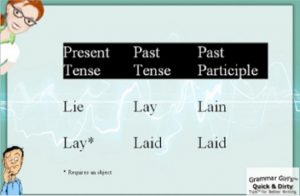My friend Bob, a high school English teacher and fierce grammar nerd, once told me that he “just had to memorize” lie vs lay.
Indeed, that may be the only way to remember how to use these annoying verbs correctly.
However, if your memory serves you as poorly as mine does, maybe these definitions and tricks will help.
I’ll start with the present tense.
Here goes:
To Lay:
The verb to lay needs to be followed by what Bob would call a “direct object.”
Or, as I think of it, lay needs to be followed by a thing (or things) that are being put somewhere.
Examples:
Bob wants to lay those grocery bags down before discussing grammar rules. (grocery bags are the things that follow lay.)
I need to lay myself down for a while. (myself is the thing I need to lay down. Or put down. Or place on the couch.)

http://ubilio.com/
Egg is the direct object of that hen’s question.
To Lie: (as in going to bed. not as in saying something that isn’t true)
The verb to lie does not need a direct object. No thing is necessary after the verb to lie.
Examples:
Bob had to lie down after trying to explain all of this to me.
Lie here and relax until you feel better.
Neither of these sentences has a direct object after the verb to lie. You can just lie down, plain and simple. Right? Right.

http://www.nadineducca.cat/2013/10/
Note: the same rules apply to the –ing forms of lay and lie, known as present participles:
Examples:

The dog is lying down. (to lie)
Those men are laying down bricks. (to lay)

http://www.fls-pgh.com ?
And now we come to the past tense:
The past tense of to lay is laid. And the past tense of to lie is, unfortunately, lay. I will stick to G-rated examples.
He laid the soccer ball down on the bench. (Soccer ball is the thing or direct object that follows laid.)
She lay quietly for several hours. (No direct object necessary.)
And past participles:
The simplest way I can define past participles is that they describe actions that are already finished and often follow the words has or have.
The past participle of to lay is laid.
The past participle of to lie is lain.
Examples:
He has laid his hat down over there on the floor. (Hat is the direct object.)
They have lain awake for three days.
Here’s a tenses chart for lie and lay from Mignon Fogarty, aka Grammar Girl:

www.quickanddirtytips.com/grammar-girl
This is by no means a definitive list of the ways in which lie and lay confuse most of us. I’m sure I’ve left out any number of examples. So, please let me know whether this has been helpful, and whether you’d like to see me add or correct something.
Elite quality private proxies, Indefinite data transfer useage, 1000 mb/s superspeed, 99,9 uptime, Not for continuous IP’s, Certainly no wearing restrictions, A number of subnets, USA or even Eu proxies – Acquire Presently – https://DreamProxies.com
I am impressed with this website , very I am a big fan .